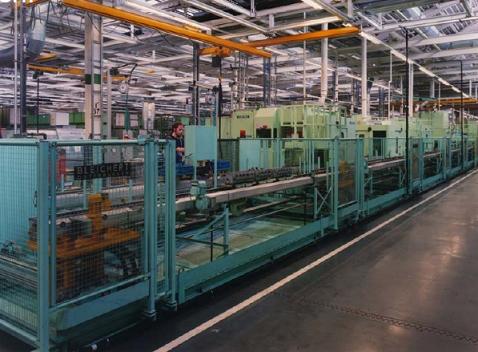

The flexible transportation system of Production 2000+ was tested in three main steps: simulation, demonstrator and prototype.
First, the flexible transportation system and the associated agent-based control system were tested in a large series of realistic simulations.
The simulations included the simulation of the physical material flow, of the processing steps in a machine and the control decisions of the agents. The simulations thus included the physical and the (agent-based) control layer. The simulated production systems were configured on the basis of the processing graphs of existing products of Mercedes-Benz, resulting in configurations of typically 30 to 40 machines (per simulation). Furthermore, the simulations were run with realistic failure rates (MTBF/MTTR) for the machines (taken from an existing manufacturing line in Untertürkheim).

Fig 1. Simulation of P2000+ system.
The results of the simulations were compared to realistic simulations of comparable transfer lines, which have been previously validated against data from existing manufacturing lines. The simulation results showed that the throughput of the P2000+ system increased by more than 20% over the throughput of existing manufacturing lines, resulting in a huge increase of the output. This output increase implies significant costs savings, since more parts are produced on the same line, thus reducing the costs per part. [Bussmann 2000]

Fig 2. Simulation of transfer lines.
The simulation results of the P2000+ system were also compared to an ideal production line without any failures. The comparison showed that the P2000+ system (under certain conditions) produces a nearly optimal throughput (99.7% of the theoretical optimum). [Bussmann 2000]
To further test the concept of an agent-based control system before investing into a full-blown prototype, the concept was implemented in a demonstrator. In production terms, a demonstrator is a physical installation of the production system on a scale of less than 1:1. The demonstrator for P2000+ consisted of the transportation system for three machines on a scale of approximately 1:5 (the three machines were only emulated by a single buffer space per machine). The transportation system was controlled by a prototypical implementation of the agents.
The main objective of the demonstrator was to learn more about possible implementation of the agents on control hardware and to further increase the confidence of the stakeholders into the technology. Both objectives were achieved by the demonstrator.
To finally test the concepts of P2000+ under real industrial conditions, Daimler decided in 1999 to invest into an industrial prototype of the system. In production terms, a prototype is a fully functional implementation of a concept, which can be operated and tested in a real production process (but which may or may not represent the final functionality of a product). The P2000+ prototype was thus implemented and installed next to an existing manufacturing line at a Mercedes-Benz plant in Stuttgart-Untertürkheim in mid of 1999.
The prototype consisted of six ordinary CNC machines which were connected via a P2000+ transportation system, as shown in figure 3. Each two machines had identical processing capabilities, resulting in three machine clusters (cf. the general description of the production system layout).

Fig 3. Layout of P2000+ prototype.
The agent-based control system was implemented by Schneider Electric in Seligenstadt, Germany. Each switch agent was implemented on a PLC controlling the corresponding shifting table, while each machine agent was installed on an industrial PC controlling the associated machining center [Schoop 2000]. Thus, each shifting table and each machine had its own agent. All agents were able to communicate over a local area network.
The workpiece agents, on the other hand, were not directly associated with the workpiece, because a workpiece is per se only a piece of metal with no IT processing capability (see the architecture for a general discussion of this aspect). The workpiece agents were thus implemented and operated on a cluster of industrial PCs, installed next to the manufacturing line. To link the physical workpiece with its workpiece agent, each physical workpiece was assigned an identification number. Every time a workpiece entered a shifting table or a machine, the corresponding agent informed the associated workpiece agent that the workpiece has reached its location. Due to these signals, the workpiece agents were able to keep track of the state of the workpiece and to take appropriate actions upon these events. Furthermore, to manage a large number of workpieces (a cylinder head manufacturing line may buffer up to five hundred workpieces), a single workpiece agent handles several workpieces at once (with a flexible load balancing mechanism between the workpiece agents).

Fig 4. Production 2000+ prototype. (Courtesy of Bleichert, Osterburken)
After installation, the prototype was tested by using it as a bypass to an existing manufacturing line. For three weeks, workpieces were taken out of the existing line, processed by the prototype and fed back into the existing line (at a later stage). The prototype thus had to provide the same processing features as the bypassed region of the existing manufacturing line, with the same throughput and in particular with the same quality.
The performance test showed that the prototype not only fulfilled the requirements of the existing process, but was also able to confirm all the results of the simulation. In particular, the prototype was more robust than the existing transfer line and achieved a throughput increase of 20%.
After the successful performance tests, the P2000+ system was deployed in day-to-day operation (see here).